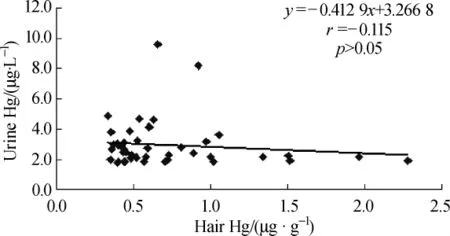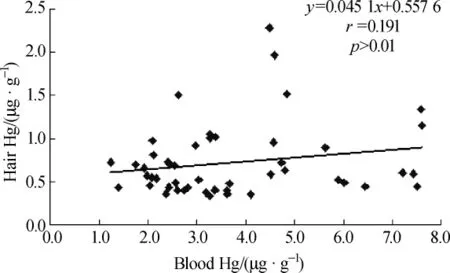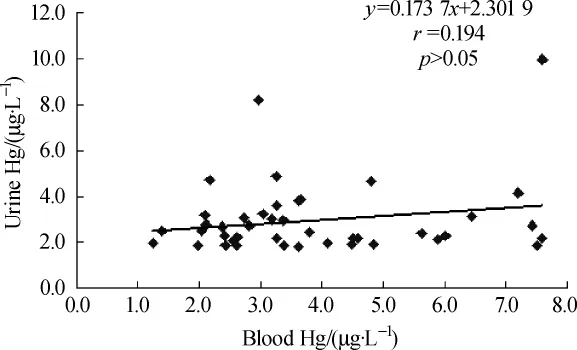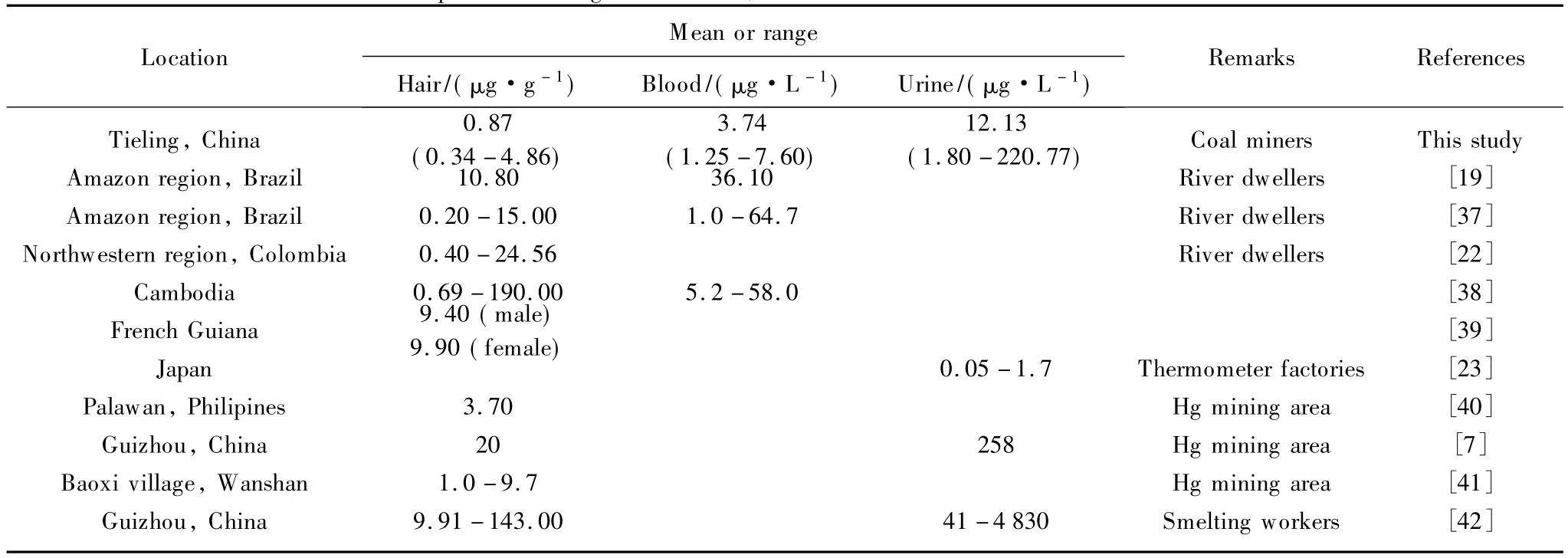Mercury Exposures in Population from Tieling Coal M ine Area,Liaoning,China
2015-08-07TANGWei唐蔚CHENGJinping程金平ZHAOWenchang赵文昌ZHAOXiaoxiang赵晓祥WANGWenhua王文华
TANGWei(唐蔚),CHENG Jin-ping(程金平),ZHAOWen-chang(赵文昌),ZHAO Xiao-xiang(赵晓祥),WANGWen-hua(王文华)
1 School of Environmental Science and Engineering,Shanghai Jiao Tong University,Shanghai200240,China
2 School of Environmental Science and Engineering,Donghua University,Shanghai201620,China
Mercury Exposures in Population from Tieling Coal M ine Area,Liaoning,China
TANGWei(唐蔚)1,2,CHENG Jin-ping(程金平)1*,ZHAOWen-chang(赵文昌)1,ZHAO Xiao-xiang(赵晓祥)2,WANGWen-hua(王文华)1
1 School of Environmental Science and Engineering,Shanghai Jiao Tong University,Shanghai200240,China
2 School of Environmental Science and Engineering,Donghua University,Shanghai201620,China
M ercury(Hg)concentrations were determ ined in human hair,blood and urine samp les from Tieling coalm ine area,to assess the potential health risks associated with Hg due to coal m ining activities.The total Hg levels in hair(average0.87μg/g)and blood (average 3.74μg/L)of coalm iners were quite low at around the same levels as the general population,but the urine Hg levels (average 12.13μg/L)were much higher than those from adm inistrators and control group.This study indicated thatworkers mainly exposed to inorganic Hg through long-time inhalation contam inated air and dust;however other population mainly exposed tomethylmercury(M eHg).
hair;blood;urine;mercury(Hg);coalmine area
Introduction
Mercury(Hg)is a hazardous,persistent,and globally distributed pollutant in the environment due to its characteristic properties such as low melting and boiling points,conversion between chemical forms and participation in biological cycles.It can be found in metal form,such as Hg salts and organic Hg compounds.Hg is not naturally found in foodstuffs,but itmay turn up in food as it can be spread within food chains by smaller organisms that are consumed by humans,for instance through fish[1].Exposure to hazardous Hg levels can cause many diseases such as permanent neurologic and kidney impairment[2].The potential risk of health hazards of human through Hg exposure has been assessed by estimating themetal contents in breast m ilk,blood,hair,urine,nail,adipose tissues and various organs[3-5].In the United States Environmental Protection Agency(U.S.EPA)Mercury Study Report to Congress[6],the EPA estimated that7%of women of childbearing age would have blood Hg concentrations greater than those equivalent to the reference dose.The biological health effects of Hg pollution in Hg or gold mines have been reported[7-9].However,there is still a paucity of Hg pollution and its potentialnoxious effectson people from coalmine areas.
China is one of the few countries in the world whose coal consumption constitutes more than 75%of the country's total energy sources[10].In 2006,China consumed 1 238.3Million t of the oil equivalent of coal,nearly 40.1%of the world consumption.with the rapid development of economy,coal consumption has been increasing considerably.Though it is estimated that coal constitution will drop to about 54%in 2020[11],the total amount of raw coal as consumed is expected to as much as 2.6 billion t till then[10].Coal is the primary energy source,and a great amount of Hg was emitted into the atmosphere in the coal combustion process in China[12-13]. China also is estimated to be the largest producer of Hg em issions[14].Wang et al.indicated that the estimated Hg em issions to the atmosphere from coal combustion in Chinawere 213.8 t in 1995[15].Streets etal.reported that the estimated Hg em issionswere 202.4 t in 1999[16]and Jiang et al.estimated 219.5 or 161.6 t(based on two different coal Hg contents)in 2000[17].Hg emission must directly or potentially have a significant effect on human health.The toxicity of Hg depends on its chemical form.Inhalation ofmercury vapor and ingestion ofmethylmercury(MeHg)via the diet are themost important routes of human exposure to Hg[18].For occupational exposure (such as Hgmines,Hg-based gold extraction,and thermometer factories),inhalation of Hg vapor is themost important route of human exposure to Hg,while the dental amalgam filling is the predominant source of human exposure to elemental Hg in the general population[3].Hair Hg is predom inantly composed of MeHg,and hair total Hg orMeHg is a good biomarker of MeHg exposure level[19].MeHg enters hair follicles in direct proportion to its level in blood and is incorporated into the hair shaft.Normal hair grows approximately 1 cm per month,so hair Hg may reflect organic Hg exposure during the past,depending on hair length[20].Themajor form of Hg in the urine is inorganic Hg,and the totalmercury(T-Hg)concentration in the urine reflects the amountof inorganic Hg accumulated in the kidney,which is a good biomarker for evaluating inorganic Hg exposure[21].Similar to hair Hg,Hg concentrations in blood serves as better indicators for the evaluation of recent exposure than those in urine[22].Therefore,to obtain the basic information on human exposure to Hg due to coal m ining activities in Tieling,T-Hg was determ ined for human hair,blood and urine samples in our study.
Tieling(123°27'E-125°06'E,45°59'N-43°29'N),one of the municipalities directly under Liaoning Province,lies in the north of Liaoning Province and in themiddle section of the Songliao Plain.Tieling covers a total land area of 13 000 km2,and is a very important channel in associating Jilin Province and Heilongjiang Province with other provinces.The city is rich in coal resources and its reserves the first rank in Liaoning Province.Thus it is very meaningful to study the Hg exposure in this area.
The present study aims to assessing the potential health risks of people associated with Hg due to coalmining activities. We analyzed the T-Hg in the hair,blood and urine of coalmine workers,coalm ine administrators and local residents living in the Tieling coalmine area,Liaoning Province.
1 Materials and Methods
As already stated,Tieling City is rich in coal resources and has one of the largest coalmining bases in China.There are 36 kinds of m inerals found within this territory,including gold,silver,aluminium,chalk,coal,tabular spar andmineralwater. Among them,23 kinds have been developed.Coal is the largest of the mineral resource which is chiefly distributed in Diaobingshan City.There are21 coalm ines,and the prospected amount is 2.25 billions t,which can be mined for 80 to 100 years long.Tieling is an important energy production base for Liaoning Province.In recent years,17 billion m3of coal bed gas has been prospected and now has been exploited.
All the people selected in this study must have worked full time(the m inimum time of exposure to Hg was one year). Hair,blood and urine samples were collected from coalminers (male,n=50,average age 42.3,aged from 29 to 54)and coalm ine adm inistrators(male,n=39,average age 44.2,aged from 28 to 54;female,n=11,average age 41.4,aged from 31 to 52)from the Tieling coal m ine area,Liaoning,China.Control samples for hair,blood and urinewere collected from local residents(male,n=45,average age 43.9,aged from 24 to 56;female,n=15,average age39.5,aged from 24 to 53)living in this city.A questionnairewas utilized to collect information on residential history,occupational history,health history and the quantity of fish consumed each week.All participants joined the investigation on a voluntary basis.
Hair sampleswere cut from the base of the scalp,behind the ear,and the samples were washed with detergent,and rinsed tw ice with acetone to dry.The dried hair was cut into small pieces shorter than 2 mm with scissors and kept at 4℃[8].Blood sampleswere taken by vein puncture at the end of the workday and collected in heparinized glass tubes.Urine samples were collected during the day work shift in Hg-free polyethylene bottles,transported in a portable ice box and stored at4℃[23].
Accurately weigh out the sample(0.5 g wetweight,1m L for urine samples)into a digestion flask,add 1 m L of distilled water(not required with urine samples)and mix with 2 m L of HNO3and HClO4(1∶1),and 5 m L of H2SO4.Place boiling chips,and then w ipe the flask to ensure that residual chemicals were not spilled onto the surface.Heat the solution on a hot plate at200℃for 30 min.
T-Hg concentrations in the sampleswere analyzed using the cold vapor atomic adsorption spectrometry(CVAAS)method according to the method of Japanese National Institute for M inamata Disease[24-25],which involved reducing divalent Hg in sample solutions using SnCl2to generate Hg vapor.The detection limits were 0.01 ng/g for hair Hg,0.01μg/L for blood Hg and urine Hg.
The precision and accuracy of the T-Hgmeasurementswere checked using certified referencematerials from the Community Bureau of Reference.
Statistical analysis was performed using statistical product and service solutions(SPSS).Correlation coefficients were studied using Pearson correlation analysis.The differenceswere regarded as statistically significant at p<0.05.
2 Results and Discussion
The concentrations of Hg in the volunteers'hair,blood and urine are shown in Table 1.The same gradientof decreasing THg concentrations was found:hair Hg coal miners(average 0.87μg/g,range 0.34-4.86μg/g)>administrators (average 0.65μg/g,range 0.32-4.36μg/g)>control residents(average 0.60μg/g,range 0.09-1.71μg/g); blood Hg coalminers(average 3.74μg/L,range 1.24-7.60 μg/L)>administrators(average 2.48μg/L,range 0.76-5.80μg/L)>control(average 2.32μg/L,range 0.85-5.13 μg/L);urine Hg coal m iners(average 12.13μg/L,range 1.80-220.77μg/L)>administrators(average 2.74μg/L,range 1.31-4.92μg/L)>control(average 2.14μg/L,range 0.49-3.99μg/L).This gradient indicates that coal mine is a significant source of Hg pollution.There are trace amounts of Hg present in coal in which Hg is emitted into the environment when the fuels are burned at temperatures above 150℃,mainly inorganic Hg vapor.Then the Hg vapor is efficiently absorbed through the lung.The dissolved vapor remains in the blood long enough to cross the blood brain barrier where it is oxidized and eliminated only very slow ly as to disrupt the normalmetabolism of human.The level of urine Hg implied that coalmine workersweremore exposed to inorganic Hg through long-time inhalation contaminated air[7,26-27].At the same time,the cumulative of recentexposure to organic Hg caused increased concentrations of hair and blood Hg[28].

Table 1 T-Hg level in hair,blood and urine samples
A statistically significant correlation was observed between hair Hg or blood Hg levels and job seniority of coalm iners(r= 0.239,p<0.05;r=-0.260,p<0.05),whereas no significant correlation was observed between urine Hg levels and job seniority of coal miners(r=-0.256,p>0.05).The analysis revealed that the T-Hg contents in hair and blood were significantly correlated with job seniorities of coal m iners,because the predom inant form of Hg in hair and blood was organic Hg[7],which indicated the cumulative of exposure to Hg pollution through a period of time.However,the inorganic Hg in urine may reflect the Hg deposited in the kidney rather than present or temporary exposure,so it had no clear correlation with job seniority[29].
The results of statistical analysis indicated that the urine Hg concentration was correlated with the level of hair Hg (Fig.1,p<0.05),and a strong significant correlation was observed between hair Hg and blood Hg contents(Fig.2,p< 0.05)of coal m iners.However,the relationship between blood Hg and urine Hg levels showed no significant correlation (Fig.3,p>0.05).Furthermore,a significant correlation(p<0.01)was observed between hair inorganic Hg and total gaseous Hg in ambient air in Wuchuan Hg m ining area[30]. According to these reports,hair Hg concentration is the preferred biomarker for evaluating Hg exposure for extended periods of time such as periods of weeks or months[31].Hair incorporated Hg present in circulating blood during hair formation in the hair follicle,so the hair Hg and blood Hg concentrations were closely related.The urinal Hg level reflected the inorganic Hg exposure and was considered to be the most accurate biomarker for understanding the absorbed dose from chronic exposure to Hg vapor,so no significant relationshipswere found between urine Hg and blood Hg.The routes of Hg exposure mainly included soil ingestion,dermal absorption,air inhalation,drinking water intake and daily dietary intake[8].Horvat et al.indicated that soil,dust and dermal exposure to Hg were very low[32].For occupational exposure(such asworkers in chlor-alkali plants,Hgmines and dental clinics),inhalation of Hg vapor is the most important exposure route to mercury[4].Human exposure to MeHg is mainly related to fish consumption.Liberda et al.found blood Hg levels increased with fish consumption[33].Mortensen et al.estimated the ratio of MeHg to T-Hg increased slightly with age,with the age-related increase dependent on the magnitude of the initial value[34].

Fig.1 Relation between hair Hg and urine Hg of coalm iners

Fig.2 Relation between blood Hg and hair Hg of coalminers

Fig.3 Relation between blood Hg and urine Hg of coalm iners
In this study,the frequency of fish consumption was quite low,andmost individuals(>80%)fish intakewere less than 2 times every week.Lindberg et al.reported that T-Hg levels in hair reflected MeHg and not inorganic Hg exposure also in individuals with no fish consumption and very low MeHg exposure[35].There was no significant difference between coal miners and other population about the hair Hg levels.While coal workers urine Hg levels reflecting inorganic Hg exposure were much higher than those from administrators and control group.These indicated that coal workers had been mainly exposed to inorganic Hg through long-time inhalation contaminated air.
In our study,the concentration of T-Hg in hair samples waswell below 10μg/g,the upper lim it of normal hair T-Hg level reported by Harada et al.[36],and was generally lower than the levels reported in other studies of China and international populations(Table 2).The U.S.EPA and the National Academy of Sciences recommend keeping the whole blood mercury level<5μg/L.In our study,over 82%of the coalm iners had blood Hg contents below that level.The level of urine Hg was higher than the normal reference value of 10 μg/L(GBZ89-2007).Based on the comparison of experiment results(Table 2),we concluded thatblood and hair T-Hg level of coalminers in our study was very low,but the urine Hg was a little higher,which maybe associated with the long exposure to Hg during coal mining activities in recent years.

Table 2 Comparison of T-Hg levels in hair,blood and urine of residents from various locations
3 Conclusions
Our research results suggested a w ide variation in hair,blood and urine Hg concentrations among coal miners,coal m iner adm inistrators and control samples.The overall trend of Hg concentration was coalminers>coalminer administrators>control samples,which indicated that a coal m ine was a significant source of Hg pollution.The T-Hg levels in hair and blood of coalminerswere quite low ataround the same levels as the general population without any specific Hg contamination,but the urine Hg levels were much higher than those fromadministrators and control group.Pearson's correlation coefficients showed strong positive correlations between hair Hg and blood Hg(p<0.05)or urine Hg(p<0.05),but there was no significant correlation(p>0.05)between urine and blood,implying that workers had been mainly exposed to inorganic Hg through long-time inhalation contam inated air and dust,and other populations were mainly exposed to MeHg. Greater effortsmust be paid on protection of coalminers.
[1]Johnsson C,Schutz A,Sallsten G.Impact of Consumption of Freshwater Fish on Mercury Levels in Hair Blood Urine and Alveolar Air[J].Journal of Toxicology Environmental Health Part A,2005,68(2):129-140.
[2]Liu J,Lewis G.Environmental Toxicity and Poor Cognitive Outcomes in Children and Adults[J].Journal of Environmental Health,2014,76(6):130-138.
[3]Apostoli P,Cortesi I,Mangili A,etal.Assessment of Reference Values for Mercury in Urine:the Results of an Italian Polycentric Study[J].Science of the Total Environment,2002,289(1/2/ 3):13-24.
[4]Clarkson T W.The Three Modern Faces of Mercury[J]. Environmental Health Perspective,2002,110(suppl 1):11-23.
[5]NiW Q,Chen Y W,Huang Y,et al.Hair Mercury Concentrations and Associated Factors in an Electronic Waste Recycling Area,Guiyu,China[J].Environmental Research,2014,128:84-91.
[6]United States Environmental Protection Agency.Mercury Study Report to Congress[R].Washington DC:U.S.EPA,1997.
[7]Sakamoto M,Feng X B,Li P,et al.High Exposure of Chinese Mercury M ineWorkers to ElementalMercury Vapor and Increased Methylmercury Levels in Their Hair[J].Environmental Health and Preventive Medicine,2007,12(2):66-70.
[8]Cheng JP,Gao L L,Zhao W C,et al.Mercury Levels in Fisherman and Their Household Members in Zhoushan,China: Impact of Public Health[J].Science of the Total Environment,2009,407(8):2625-2630.
[9]Cheng JP,Yang Y C,Ma J,etal.Assessing Noxious Effectsof Dietary Exposure to Methylmercury,PCBs and Se Coexisting in Environmentally Contam inated Rice in Male M ice[J]. Environment International,2009,35(3):619-625.
[10]You C F,Xu X.Coal Combustion and Its Pollution Control in China[J].Energy,2010,35(11):4467-4472.
[11]National Development and Reform Commission.Energy Development Planning of the“Tenth Five-year”[R].National Development and Reform Commission,2007.(in Chinese)
[12]Wang L,Wang S X,Zhang L,et al.Source Apportionment of Atmospheric Mercury Pollution in China Using the GEOS-Chem Model[J].Environmental Pollution,2014,190:166-175.
[13]Tian H Z,Liu K Y,Zhou J R,et al.Atmospheric Emission Inventory of Hazardous Trace Elements from China's Coal-Fired Power Plants-Temporal Trends and Spatial Variation Characteristics[J].Environmental Science and Technology,2014,48(6):3575-3582.
[14]Dastoor A P,Larocque Y.Global Circulation of Atmospheric Mercury:a Modelling Study[J].Atmospheric Environment,2004,38(1):147-161.
[15]Wang Q,Shen W G,Ma Z.The Estimation of Mercury Em ission from Coal Combustion in China[J].China Environmental Science,1999,19(4):318-321.(in Chinese)
[16]Streets D G,Hao J M,Wu Y,et al.Anthropogenic Mercury Em issions in China[J].Atmospheric Environment,2005,39 (40):7789-7806.
[17]Jiang JK,Hao J M,Wu Y,et al.Development of Mercury Em ission Inventory from Coal Combustion in China[J]. Environmental Science,2005,26(2):34-39.(in Chinese)
[18]World Health Orgnization.Environmental Health Criteria 118: Inorganic Mercury[R].Gdeneva:World Health Orgnization,1991.
[19]Dolbec J,Mergler D,Sousa C J,et al.Methylmercury Exposure Affects Motor Performance of a Riverine Population of the Tapajos River,Brazilian Amazon[J].International Archives of Occupational and Environmental Health,2000,73(3):195-203.
[20]National Research Council.Committee on the Toxicological Effects of Methylmercury:Toxicological Effects of Methylmercury[R].Washington D.C.:National Research Council,2000.
[21]Barregard L.BiologicalMonitoring of Exposure to Mercury Vapor[J].Scandinavian Journal of Work Environment and Health,1993,19(suppl 1):45-49.
[22]Yamamura Y,Yoshida M,Yamauchi H,et al.Relationship of Inorganic Mercury Concentrations in Exhaled Air and in Blood[C].XIX International Congress on Occupational Health,Dubrovnik,Yugoslavia,1978:149.
[23]Yoshida M,Yamamura Y.Elemental Mercury in Urine from Workers Exposed to Mercury Vapor[J].International Archives of Occupational and Environmental Health,1982,51(2):99-104.
[24]National Institute for M inamata Disease.Preventive Measures against Environmental Mercury Pollution and Its Health Effects[R].Kumamoto,Japan:National Institute for M inamata Disease,2001.
[25]Ohno T,Sakamoto M,Kurosawa T,et al.Total Mercury Levels in Hair,Toenail,and Urine among Women Free from Occupational Exposure and Their Relations to Renal Tubular Function[J].Environmental Research,2007,103(2):191-197.
[26]Satoh H.Occupational and Environmental Toxicology of Mercury and Its Compounds[J].Industrial Health,2000,38(2):153-164.
[27]Feng X B,Qiu G L.Mercury Pollution in Guizhou,Southwestern China an Overview[J].Science of the Total Environment,1995,168(1):63-69.
[28]Zhang L,Wong M H.Environmental Mercury Contam ination in China:Sources and Impacts[J].Environment International,2007,33(1):108-121.
[29]Zalups R K.Molecular Interactions with Mercury in the Kidney[J].Pharmacological Reviews,2000,400(1/2/3):227-237.
[30]Li P,Feng X B,Qiu G L,et al.Mercury Exposure in the Population from Wuchuan Mercury M ining Area,Guizhou,China[J].Science of the Total Environment,2008,395(2/3):72-79.
[31]Li P,Feng X B,Qiu G L,etal.Hair Can Be a Good Biomarker of Occupational Exposure to Mercury Vapor:Simulated Experiments and Field Data Analysis[J].Science of the Total Environment,2011,409(20):4484-4488.
[32]Horvat M,Nolde N,Fajon V,et al.Total Mercury,Methylmercury and Selenium in Mercury Polluted Areas in the Province Guizhou,China[J].Science of the Total Environment,2003,304(1/2/3):231-256.
[33]Liberda E N,Tsuji L JS,Martin ID,et al.The Complexity of Hair/Blood Mercury Concentration Ratios and Its Implications[J].Environmental Research,2014,134:286-294.
[34]Mortensen M,Caudill S,Caldwell K,et al.Total and Methyl Mercury in Whole Blood Measured for the First Time in the U.S. Population:NHANES 2011-2012[J].Environmental Research,2014,134:257-264.
[35]Lindberg A,Bjornberg K A,Vahte M,et al.Exposure to Methylmercury in Non-fish-eating People in Sweden[J]. Environmental Research,2004,96(1):28-33.
[36]Harada M,Nakachi S,Cheu T,et al.Monitoring of Mercury Pollution in Tanzania:Relation between Head Hair Mercury and Health[J].Science of the Total Environment,1999,227(2/3): 249-256.
[37]Palheta D,Taylor A.Mercury in Environmental and Biological Samples from aGold M ining Area in the Amazon Region of Brazil[J].Science of the Total Environment,1995,168(1):63-69.
[38]Agusa T,Kunito T,Iwata H,et al.Mercury in Hair and Blood from Residents of Phnom Penh(Cambodia)and Possible Effect on Serum Hormone Levels[J].Chemosphere,2007,68(3): 590-596.
[39]Fujimura M,Matsuyama A,Harvard J P,et al.Mercury Contam ination in Humans in Upper Maroni,French Guiana between 2004 and 2009[J].Bulletin of Environmental Contamination and Toxicology,2012,88(2):135-139.
[40]williams T M,Apostol A N,M iranda C R.Assessment by Hair Analysis of Mercury Exposure among M ining Impacted Communities of M indanao and Palawan,the Philippines[J]. Environmental Geochemistry and Health,2000,22(1):19-31.
[41]Feng X B,Li P,Qiu G L,et al.Human Exposure to Methylmercury through Rice Intake in Mercury M ining Areas,GuiZhou Province,China[J].Environmental Science and Technology,2008,42(1):326-332.
[42]Li P,Feng X B,Qiu G L,et al.Mercury Exposures and Symptoms in Smelting Workers of Artisanal Mercury M ines in Wuchuan,Guizhou,China[J].Environmental Research,2008,107(1):108-114.
X592
A
1672-5220(2015)04-0609-04
date:2014-05-12
National Natural Science Foundation of China(No.21177087)
*Correspondence should be addressed to CHENG Jin-ping,E-mail:jpcheng@sjtu.edu.cn
猜你喜欢
杂志排行
Journal of Donghua University(English Edition)的其它文章
- Numerical Reality Method of the M icroburst Model
- Corporate Governance,Government Regulation and Bank Stability
- Cracking Patterns of Shear Walls in Reinforced Concrete Structure due to Strong Earthquake Based on Mohr-Coulomb Criterion
- Cooperative Compressive Spectrum Sensing in Cognitive Underwater Acoustic Communication Networks
- Numerical Simulation of Gas-Solid Two-Phase Flow in Reverse Blow ing Pickup Mouth
- Fuzzy Model Free Adaptive Control for Rotor Blade Full-Scale Static Testing
